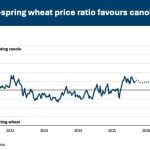Smithfield Foods, the hog slaughter and processing giant, is shutting six plants in the United States.
That will have zero influence on hog prices, according to analyst Rich Nelson of Allendale Inc. in Illinois.
“This will have no impact whatsoever on any pricing level. It will have no impact on packer willingness to buy hogs,” he said.
That’s good news for producers who have anticipated a price recovery from last year, which many analysts pegged as the low part of the four-year hog cycle.
Read Also

Farmers urged to be grain-safe this fall
Working around grain bins comes with risk, from farmers falling to drowning in grain: Experts have five tips to help avoid grain-related accidents this harvest.
Smithfield’s announcement refers only to processing plants, not slaughter plants, so there is no reason to expect the company to reduce its demand for live pigs, said Ron Plain of the University of Missouri.
“Smithfield is trying to get out in front of the reality that there are going to be fewer hogs in North America this year than last year,” said Plain.
“Last year’s hog numbers are likely to be the high water mark for several years, which means we have surplus processing capacity and some of it needs to be shut down.”
Instead of reducing hog purchases, Nelson said companies like Smith-field will be buying every pig they can get in order to keep their remaining processing plants going.
“The good news is that we still have Smithfield buying the same number of hogs that we did before, and we’re not going to have a bottleneck from the packer level on buying hogs.”
Some of Smithfield’s processing plants have operated at only half capacity in the past year, while other plants, acquired through a takeover of another company, duplicated capacity unnecessarily.
Shutting some plants won’t reduce Smithfield’s processing performance much, according to Plain and Nelson.
Smithfield’s corporate earnings have been squeezed in recent months, down to $4.2 million in its second quarter compared to $17.4 million one year previously.
Pork production made the company money, but hog production cost it $96.8 million in losses compared to a profit of $111.6 million in the same quarter a year before.
High-priced feed was the main factor in the reversal of fortunes in pig production.
Plain said an interesting feature of Smithfield’s closure of the plants is how quickly the company moved. Biting the bullet now is smarter than getting shot a few months later.
“In better financial times we might see the Tysons and the Smithfields and the Swifts try to outlast each other and force the other one to say uncle and cut back in processing capacity, but given most people’s weakened situation they decided they didn’t want to outlast, and to instead get out ahead of the situation,” said Plain.
“They didn’t want to play a game of chicken and see who gives up first.”















